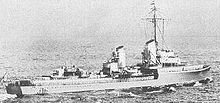- Operation Wikinger
-
Operation Wikinger (German for Viking) was a sortie into the North Sea by the 1st Destroyer Flotilla of the Kriegsmarine, in February 1940. During this operation, poor inter-service communication and cooperation between the Kriegsmarine and the Luftwaffe and inexperience resulted in the loss of two German ships through friendly fire bombing and German or British mines. No Allied forces were involved.
Contents
Background
On February 1940, the Kriegsmarine had grown suspicious of the activities of British fishing vessels around the Dogger Bank. Luftwaffe reconnaissance flights reported the presence of submarines, so it was decided to intercept the British vessels with the six destroyers of the 1st Destroyer Flotilla: Friedrich Eckoldt (flotilla leader), Richard Beitzen, Erich Koellner, Theodor Riedel, Max Schultz and Leberecht Maass, escorted by Luftwaffe fighters.
At about the same time, X. Fliegerkorps of the Luftwaffe planned to execute a postponed anti-shipping operation over the North Sea, using two squadrons of Heinkel 111 bombers.
The Kriegsmarine had been denied its own air wing ("Marineflieger") and was dependent upon the Luftwaffe for air support, which remained under direct Luftwaffe control. Exchanges of information and plans and requests for support had to traverse a lengthy command chain.
Execution
 The sunk destroyer Z 1 Leberecht Maass
The sunk destroyer Z 1 Leberecht Maass
The sortie began at 19:00 on 19 February 1940. The flotilla proceeded at high speed through a cleared channel between German defensive minefields, without the fighter air cover that had been requested. In the sea and weather conditions, they were clearly visible, through the wakes that their speed produced, but they wished to clear the mined area quickly.
The flotilla was passed twice by a German bomber, which was uncertain of the ships' status. It made no recognition signals and, as a result, it was taken to be a British reconnaissance aircraft and fired upon by the ships. Fire was returned by the aircrew. Each side was now convinced of the other's hostility.
The German aircraft attacked. On the first bombing run, one of three bombs hit Leberecht Maass. While the rest of the flotilla was ordered to continue in formation, Friedrich Eckoldt went alongside ready to help. The Heinkel made a second run and two bombs hit Leberecht Maass, which was broken in two by large explosions. The bomber returned to its base, unaware, until then, of the other ships in the flotilla.
Immediately after the explosions, the remainder of the flotilla attempted to rescue the crew. Just after 20:00, Max Schultz exploded and sank, probably striking a mine. What followed was chaos. There were many erroneous reports of air attack, submarines detected and torpedoes; ships dashed back and forth. Theodor Riedel dropped depth charges on a supposed submarine and the explosions temporarily jammed its rudder.
After 30 minutes of panic and mayhem, the flotilla commander ordered the surviving four ships to return home. There were no survivors from Max Schultz and only 60 from Leberecht Maass: in all, 578 German sailors died.
Aftermath
The initial view of the naval command in Wilhelmshaven — Marinegruppe West — was that the flotilla had run into a German minefield. The presence of enemy submarines was discounted. At 23:00, naval command received a report from X. Fliegerkorps that a ship had been engaged and destroyed in the general area of the sinkings, at the same time. Subsequent reports appeared to confirm the "friendly fire" attack.
Neither the destroyers nor the Luftwaffe squadrons had been told of the other's presence, although information had been passed to the relevant commands. By the time the risks became apparent, it was too late to advise aircrews.
The official German investigation showed that there had been inadequate communication between the Luftwaffe and the Kriegsmarine. None of the responsible officers were called to account.
A subsequent mine sweep of the area found some active mines that had been laid around 9 and 10 February by the British 20th Destroyer Flotilla. It remains unclear, if Leberecht Maass was sunk in the second air attack, or if it additionally struck a mine. Most probably, Max Schultz was sunk by either a British or German mine.
See also
External references
Categories:- Conflicts in 1940
- Atlantic and Arctic theatres of World War II
- Friendly fire incidents
Wikimedia Foundation. 2010.
